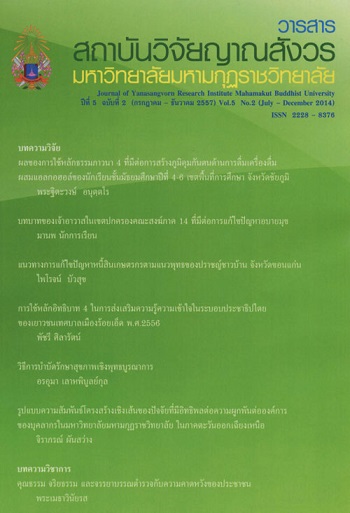A Model of Linear Structural Relationships of Factors Affecting Organization Commitment of Personnel in Mahamakut Buddhist University in the Northeast
Main Article Content
Abstract
The objectives of this research were : to develop a model of linear structural relationships of the factors affecting organization commitment, to inspect the consistence of the developed model with the empirical data, and to study the influences direct, indirect and total effective of the factors affecting the organization commitment of personnel in Mahamakut Buddhist University in the Northeast Region. The research samplings were totally 560 in number, consisting of staffs and lecturers. The research instrument was questionnaire with its reliability of 0.97, and the IOC value lying between 0.85-1.00. The computer program was used for data analysis. The research results were as follows : The development of the model of linear structural relationships of the main factors affecting organizational commitment of personnel in Mahamakut Buddhist University in the Northeastern Region consisted of totally 28 variables, of which latent and observed variables were 7 and 21 in number, in that order. The observed variables could be classified as three items for Organization Commitment; two items for Organization Culture; four items for Change Agent; three items for Participatory Management; two items for Self-Esteem; four items for Job Satisfaction and three items for Organization Atmosphere. And the test of the goodness of fit on the developed model with the empirical data showed that both were satisfactorily consistent, as could be seen from the statistical analysis result that revealed the P-Value = 0.78; Chi – Square ( ) = 122.887; Degree of freedom (df) = 102; Chi – Square per Degree of freedom ( /df ) = 1.205; the Root means square error of approximation (RMSEA)= 0.019, Goodness of fit index (GFI) = 0 .980, and Adjusted goodness of fit index (AGFI ) = 0.954, Normed fit index (NFI) = 0.985; Comparative fit index(CFI) = 0.997, respectively. And the factors that rendered the direct impacts on the organization commitment were Self-Esteem, Participatory Management and Organization Atmosphere, whereas the factors that exercised the indirect influence were the Job Satisfaction, Change Agent and Organization culture, and those with total effective influence included the Self-Esteem, Change Agent and Job Satisfaction.
Article Details
References
ทวิพันธ์ พัวสรรเสริญ. (2552). ความผูกพันต่อองค์การของอาจารย์มหาวิทยาลัยภาครัฐในเขต กรุงเทพมหานคร. ดุษฎีนิพนธ์ สาขาวิชารัฐประศาสนศาสตร์ มหาวิทยาลัยรามคำแหง.
รัตนา บุตรดี. (2553). ปัจจัยเชิงสาเหตุที่มีอิทธิพลต่อความยึดมั่นผูกพันต่อองค์การของบุคลากรสาย สนับสนุนในสถาบันอุดมศึกษาของรัฐ. วิทยานิพนธ์ การวิจัยการศึกษามหาบัณฑิต
Fjortoft, I. And J. Sageie (1993). The Natural Environment as a Playground for Children: Landscape Description and Analysis of a Natural Landscape. Landscape and Urban Planning 48(1/2) 83-97


